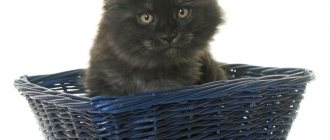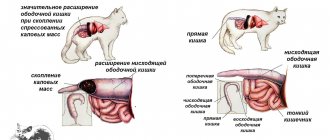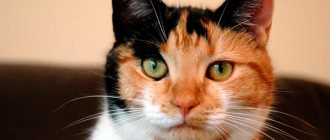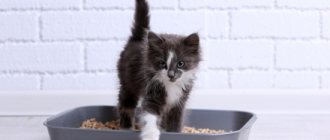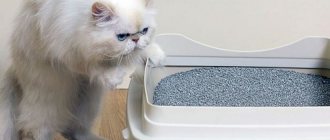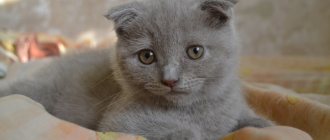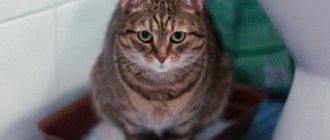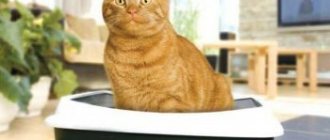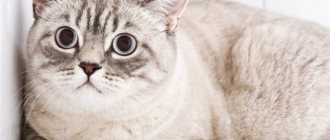When a small kitten appears in the house, considerable responsibility falls on the owner. One of the important factors in a pet’s health is the functioning of the digestive system. Simply put, how a kitten will feel is influenced by how often it visits the toilet. In our article we will talk about how long a pet should go to the toilet, and how to help him cope with this difficult moment.
How do newborn kittens go to the toilet?
Some novice cat breeders are of the opinion that a newborn kitten does not walk at all, not only in a big way, but also in a small way. However, this is an erroneous judgment. The fact is that during this period the mother cat carefully looks after him. It is she who massages the babies' anus and bladder with her rough tongue, while simultaneously licking everything that comes out of the anus. That is why the cat’s nest is clean and free of unpleasant odors. The kitten enjoys such courtship from the cat until about one month, after which everything falls on the attentive owner.
Diarrhea in a cat, causes
Diarrhea in cats develops quite often . A one-time loose stool should not frighten the owner, since it is usually a failure that occurs due to minor reasons that do not require a visit to a specialist.
Diarrhea in cats develops quite often
Diarrhea for 2 days or more requires therapy.
There are several main causes of diarrhea in cats:
- Feed intolerance. The animal’s body may not accept the food offered, even when it is of high quality. Most often, the phenomenon is observed when giving low-grade ready-made feed and milk. The problem can be solved by adjusting the diet.
- Sudden change in diet. The cat's intestines and stomach must gradually adapt to the new diet. If it is changed abruptly, diarrhea will easily occur due to irritation of the mucous membrane.
- Worm infestation. The toxins released by worms lead to poisoning, causing loose stools.
- Metabolic disease. This affects most processes in the animal's body, including the number of bowel movements and the density of feces.
- Bowel disease. Diarrhea most often develops with infectious lesions, but may also indicate tumor neoplasms and various ulcerative pathologies. A blood test will be required for diagnosis.
A veterinarian can determine the exact cause of diarrhea in a cat after an examination.
How often should a one-month-old kitten go to the toilet?
In the first month of life, babies are preparing to go to the toilet on their own. At this time, their digestive tract is actively developing. Their intestines are strengthened and populated with beneficial bacteria, which helps them visit the litter box every day. If a kitten sucked the milk of its mother cat, with a gradual transition to complete food, this would have a good effect on the functioning of the digestive tract. The food should be creamy and finely chopped, which will help better passage through the intestines and the development of the digestive process.
Ideally, one-month-old kittens poop on their own approximately 3 to 6 times a day. Their feces should have a mushy consistency, without any mucus or undigested food. The owner should be alerted to the presence of loose stools. Sometimes it can be difficult to check the presence of feces at this age, since the kitten does not yet know how to use a litter box and relieves itself with great pleasure in different parts of the apartment. If the pet is cheerful and cheerful, full of energy, then there is no need to worry about the fact that you cannot calculate how often the cat walks. You can check the quality of the digestive system by examining the tummy. Healthy kittens have a soft and painless belly.
Elderly cats
Elderly individuals are less mobile, consume less food, which can cause digestive disorders. As a result, the norm is considered to be the appearance of feces in the tray once every two days.
The stool may have a soft or hard consistency. Their color is possible both light and dark. If an older pet feels fine and does not constantly scream due to pain or when going to the toilet, then there is no need to consult a veterinarian.
How often should a three month old kitten go to the toilet?
From the age of one month, the kitten switches to nutritious food. As a rule, up to three months his nutritional diet and, accordingly, the nature of his feces change. The feces become more shaped. You can understand how many times a day a kitten should go to the toilet by the nature of the baby’s diet. If his food includes plant fiber, then this process will occur more often, but if the food contains a large amount of protein, then less often. The most important thing during this period is that the cat poops every day, and that the feces are free of blood, mucus, and undigested food.
How to stop a cat from shitting in the wrong place: folk remedies
It is quite difficult to wash off the marks. The process becomes more complicated if the pet updates them from time to time. It is not enough to simply wash them with disinfectants; you need to use some tricks. You need to spread your scent in these places, leave your “marks”. For these purposes, you can use perfume or clothes that smell of sweat.
Cats don't like citrus smells, so you can spray essential oils on their favorite corners. The pet will not shit where it eats, so it is worth leaving its food in such places.
Another option is to place extra litter trays where he defecates frequently. Once the cat chooses one of the litter boxes, the rest can be removed.
How to determine that a kitten wants to go to the toilet?
Many inexperienced owners are afraid that they will not be able to determine when the kitten wants to poop. If a cat scratches the surface with its paws, the owner should transfer it to the tray as soon as possible. Usually the kitten understands from the first time what is required of him.
Another way to determine that a cat wants to go to the litter box is this behavior when he seems to sniff around, as if looking for a place. It is also worth looking at the pet’s eyes; if the owner sees that the cat seems to be glazed over, then he is definitely thinking about his goal. As soon as the cat begins to show such signs, it means that she wants to poop.
What to do if the cat does not eat for 5 days?
If a nursing or pregnant cat does not eat, you should immediately contact a veterinarian - take the animal to the clinic or call a specialist to your home. As cats age, their appetite decreases and they may eat food less readily. It is recommended to reduce the amount of food while maintaining the diet to which the cat is accustomed.
Interesting materials:
What to do if one AirPod earphone stops working? What to do if fast charging stops working? What to do if it says the program has stopped working? What to do if Rostelecom Internet does not work well? What should I do if the Internet does not work after updating Windows 10? What to do if your Windows 7 desktop disappears? What to do if Pubg Mobile doesn't work? What to do if the remote control for the Beeline set-top box does not work? What to do if the work mouse does not work on the laptop? What to do if only one AirPods works?
Why do problems with stool occur?
If an older kitten with well-opened eyes eats and drinks well, but cannot walk around every day, then there are the following reasons for this:
- Stress. Very often, a kitten suffers from constipation due to stress. Early weaning from a cat has a particularly difficult effect. The kitten, missing its mother cat, sometimes experiences difficulty passing stool for 5 days. If kids in a new home cannot go to the toilet on their own during this time, then there is nothing wrong with that. If the situation does not resolve after 5 days, then you need to visit a veterinarian. You need to try to make the cat calm down; as soon as he gets used to his new place of residence, the situation should resolve itself.
- A kitten may have difficulty passing stool if it has an improperly balanced diet. When a cat finds itself in a new home, you should try to initially stick to the same menu as the old owners. It is best to use specially formulated food for babies. When a cat eats natural food, it is better to include plant foods, boiled meat, and cereals. After the new owners select suitable food for the babies, they themselves begin to go to the toilet. How many times a cat goes to the litter box depends on what it eats. He can go up to 4 times a day if he eats food rich in fiber; when eating meat, cats visit the litter box about 2 times a day.
- Another common cause is constipation. When a kitten cannot poop for about a week, it may have a health problem, which led to the development of a similar situation. In this case, the pet must be shown to a veterinarian; only he can correctly assess the situation and prescribe treatment.
How to prevent constipation
There are many different ways to prevent constipation in cats. Some methods work better, some worse. It all depends on your cat.
Some remedies that may help
Vegetables
Vegetables can help relieve constipation in cats: boiled pumpkin, carrots, broccoli or green beans. Vegetables are included in SUPERPET in small quantities, but you can also buy them separately and add them to your food if necessary. Vegetables in a cat's diet have two positive effects:
- the moisture content of food increases, making it easier for food to move through the intestines;
- the proportion of fiber increases, which improves intestinal motility.
Vegetables should be introduced into your pet’s diet carefully and little by little so as not to cause gas.
More food
The more often cats eat, the more often they defecate. With frequent emptying of the stomach, the stool does not have time to become too dry. Sedentary cats who eat little are more likely to be constipated than active cats with a good appetite.
cat hair
Cat hair and prey hair increase the volume of feces. Cats eat their fur when they groom themselves. Do not get carried away with combing and washing your pet: this way you deprive him of a natural laxative. Cats that eat natural food practically do not regurgitate hairballs. If your cat spits up hair frequently, eats a lot of grass, and is vomiting, something is wrong. In this case, you need to contact a veterinarian.
Magnesium
Magnesium is responsible for muscle function. It relaxes muscles and promotes normal functioning of the gastrointestinal tract. Thanks to magnesium, the amount of fluid in the large intestine of cats increases: the stool becomes softer. But magnesium is associated with the formation of struvite crystals in urine. Excess crystals cause urolithiasis. Therefore, in many feeds the proportion of magnesium is reduced. Lack of this element leads to constipation. It is important that cats consume enough magnesium.
Raw liver and fats
Raw liver is a mild natural laxative. Fats help speed up digestion and make trips to the litter box more frequent. Instead of fattier types of meat, you can add rapeseed or sunflower oil to your food. Some cats love olive oil. Cats do not digest vegetable fats well; the oil can help with constipation as a lubricant.
Ground sunflower seeds
Sunflower seeds can be ground in a coffee grinder and added to food. The seeds are practically not digested, so the stool becomes bulkier. By adding crushed seeds to food, you imitate the stomach contents of mice.
Ground flaxseeds
Raw flaxseeds can be dangerous for cats. They contain substances that, when water is added, turn into hydrocyanic acid. This is a very dangerous toxin. Therefore, before giving flaxseeds to cats, they need to be boiled. Boiled crushed flaxseeds make stool softer.
Psyllium seed husk
This remedy is also known as psyllium. People often use psyllium as a remedy to prevent constipation. Some veterinarians recommend it for cats that suffer from constipation. However, if you give cats psyllium for a long time, their body gets used to it and it stops helping. Therefore, psyllium can be used as a short-term therapeutic agent.
Water
Water will not help relieve constipation. The amount of urine will increase, but the stool will not become softer. As your cat starts drinking more, she will eat less. This is because the same amount of food will contain more liquid. Due to the fact that the cat will eat less, less food will pass through the gastrointestinal tract. The cat's condition will worsen.
Diagnosis of frequent urination
Urinary problems in cats need to be treated comprehensively. In order to select the most adequate treatment, you need to conduct a thorough diagnosis and establish the cause. Laboratory tests of blood and urine are prescribed. Laboratory analysis may contain mucus, epithelium, pus, salt crystals, protein compounds, leukocytes or red blood cells, which indicates the development of an inflammatory process with the presence of pathogenic microflora.
Bacteriological cultures are also carried out to isolate the causative agent of infection. Inflammation can be triggered by streptococcal infection, chlamydia, Escherichia coli or Pseudomonas aeruginosa. Based on the results of the bacteriological study, an antimicrobial agent is selected aimed at destroying a specific type of pathogen.
To make an accurate diagnosis, especially if cystitis is suspected in a cat, cystoscopy is performed. Mandatory studies are radiography of the pelvic organs and ultrasound examination of the abdominal organs.
If you suspect that a cat has developed cystitis, accompanied by a frequent urge to urinate, in addition to laboratory tests, cystography with a contrast agent is performed, allowing you to visualize the pathological process occurring inside.
Preparations for normalizing stool and treating constipation
According to their action, laxatives can be divided into several groups:
- Irritating laxatives – tablets, suppositories, drops. They irritate intestinal receptors and cause increased peristalsis.
- Increasing the volume of intestinal contents are ballast substances (bran, flax seed).
- Helping to soften the contents - liquid paraffin, petroleum jelly.
- Osmotic agents increase the fluid content in the intestinal lumen (lactulose, lactitol, macrogol/polyethylene glycol).
All of the above groups of drugs have strengths and weaknesses (You can read more about the types of laxatives, their advantages and disadvantages in the article “How to choose the right laxative?”). However, to solve the problem, an integrated approach to treatment will give the best result. A combination of physical activity, proper diet, drinking enough water and the use of laxatives allows you to restore regular bowel movements and restore the joy of life3. To normalize stool and treat constipation, the optimal choice would be osmotic agents8, in particular the drug Duphalac®.
